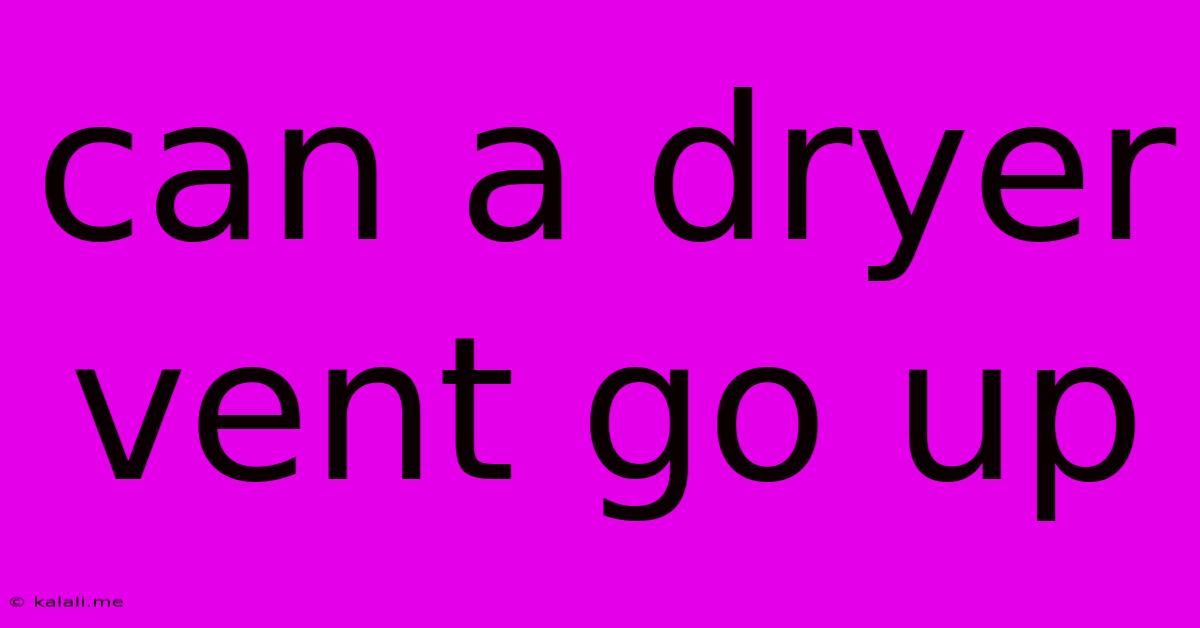Can A Dryer Vent Go Up
Kalali
May 23, 2025 · 3 min read

Table of Contents
Can a Dryer Vent Go Up? Understanding Dryer Vent Installation Best Practices
This article explores the crucial question of dryer vent placement, specifically whether a dryer vent can go up. While seemingly simple, the correct installation of your dryer vent is vital for safety and efficiency. Improper venting can lead to lint buildup, fire hazards, and reduced dryer performance. Let's delve into the details to ensure you're making the safest and most effective choices for your home.
Understanding the Risks of Improper Dryer Vent Installation
A blocked dryer vent is a serious fire hazard. Dryer lint is highly flammable, and a build-up within the venting system can easily ignite. This is why understanding and following best practices for dryer vent installation is non-negotiable. Aside from fire risk, a poorly installed vent can also lead to:
- Increased drying time: Restricted airflow means your clothes take longer to dry, wasting energy and money.
- Excessive heat: A clogged vent traps heat, potentially damaging your dryer and potentially causing issues with your home's structure.
- Reduced dryer lifespan: The strain on your dryer from inefficient venting will shorten its overall lifespan.
So, Can a Dryer Vent Go Up? The Answer is: Yes, But With Cautions.
While dryer vents can be installed vertically, this approach necessitates careful consideration. The key is to minimize the number of bends and ensure a relatively straight path for the airflow. Gravity plays a role here; lint tends to settle at low points in the vent. Therefore, a purely vertical vent with minimal bends is less prone to lint buildup than a vent with sharp turns or excessive length.
Best Practices for Upward Dryer Vent Installation:
- Minimize vertical length: Keep the vertical section as short as possible to reduce the chance of lint accumulating at the top of the vent.
- Avoid sharp bends: Sharp 90-degree turns are strongly discouraged. Opt for gentler, 45-degree bends to encourage smooth airflow.
- Regular cleaning: Regardless of venting configuration, regular cleaning of your dryer vent is essential. Professional cleaning is recommended at least once a year to prevent lint buildup.
- Proper venting material: Use rigid metal venting, avoiding flexible plastic ducts which are more prone to collapse and lint buildup. Rigid metal vents are easier to clean and safer.
- External venting: Ensure your vent terminates outside, and not inside your home or attic space.
- Professional installation: If you are unsure about any aspect of your dryer vent installation, consult a qualified HVAC professional. They can assess your specific situation and ensure correct installation.
Alternatives to Upward Venting:
If possible, horizontal venting is generally preferred as gravity assists in keeping the lint moving through the vent. However, situations where only upward venting is feasible necessitate following the guidelines above meticulously.
Conclusion: Prioritize Safety and Efficiency
Whether your dryer vent goes up, down, or horizontally, the emphasis should always be on safety and efficient airflow. By following best practices, regularly cleaning your vent, and potentially consulting with a professional, you can ensure your dryer operates safely and effectively for years to come. Remember, preventing a dryer fire is paramount – don’t compromise on safety.
Latest Posts
Latest Posts
-
Sos 5 16 Refers To Prophet Muhammad
May 23, 2025
-
Why Do I Have 2 Water Softener Tanks
May 23, 2025
-
Do I Need The Screen In My Shower Head
May 23, 2025
-
Fact Check Nixon Campaign Slogan Cant Lick Our Dick
May 23, 2025
-
In Rc Circuit Should Capacitor Be First Or Resistor
May 23, 2025
Related Post
Thank you for visiting our website which covers about Can A Dryer Vent Go Up . We hope the information provided has been useful to you. Feel free to contact us if you have any questions or need further assistance. See you next time and don't miss to bookmark.